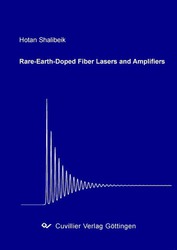| Departments | |
|---|---|
| Book Series (96) |
1378
|
| Nachhaltigkeit |
3
|
| Gesundheitswesen |
1
|
| Humanities |
2364
|
| Natural Sciences |
5406
|
| Mathematics | 229 |
| Informatics | 319 |
| Physics | 980 |
| Chemistry | 1363 |
| Geosciences | 131 |
| Human medicine | 243 |
| Stomatology | 10 |
| Veterinary medicine | 108 |
| Pharmacy | 147 |
| Biology | 835 |
| Biochemistry, molecular biology, gene technology | 121 |
| Biophysics | 25 |
| Domestic and nutritional science | 45 |
| Agricultural science | 1004 |
| Forest science | 201 |
| Horticultural science | 20 |
| Environmental research, ecology and landscape conservation | 148 |
| Engineering |
1793
|
| Common |
98
|
|
Leitlinien Unfallchirurgie
5. Auflage bestellen |
|
Advanced Search
Rare-Earth-Doped Fiber Lasers and Amplifiers (English shop)
Hotan Shalibeik (Author)Preview
Table of Contents, Datei (52 KB)
Extract, Datei (150 KB)
The goals of this work are, first, to determine different parameters of rare-earth-doped fibers and glasses and, second, to develop a simulation model for rare-earth-doped fiber lasers and amplifiers in order to avoid time consuming and expensive measurements in the laboratory during the development of such devices. The model should be applicable to arbitrary rare earth devices in a variety of configurations and cover their steady-state and transient behavior. Moreover, cross relaxation processes between two different rare earth ions should be taken into account as it is commonly used for better performance of fiber lasers and amplifiers. For the simulation a couple of spectroscopic parameters are needed, which have to be obtained in advance from bulk glasses. Some parameters like the non-radiative transition rates are difficult to obtain and thus an approach is shown to fix these usually unknown values and to consider thermally coupled energy levels.
After a short introduction, which includes general laser theory and an overview of some selected solid-state and semiconductor laser systems, some properties of rare-earth-doped materials and glass hosts are discussed. The focus is Pr3+/Yb3+-doped fluoride glass and the underlying avalanche upconversion process.
Then, a coherent reflectometric technique (C-OFDR) is applied to characterize thulium-doped fluoride fiber amplifiers (TDFAs) operating in the S-band of optical communications. The optimum length of the fluoride fiber and quantities like fiber gain and optimum gain-length ratio are determined for ZBLAN fibers with different thulium concentrations. Furthermore, a frequency transfer function (FTF) method is introduced to extract fluorescent lifetimes of energy levels of arbitrary rare-earth-doped glasses and fibers from phases and/or magnitudes of the measured frequency transfer function. This method is applied to measure lifetimes of the upper laser levels of praseodymium-doped fluoride glasses, namely ZBLAN and IBZP. Some of the glass samples are co-doped with ytterbium. These results are reported together with the investigation of the concentration quenching effect. Moreover, spectroscopic results of Pr3+- and Yb3+-doped ZBLAN glasses are presented and included in the simulation model developed.
Simulations are carried out for Yb3+-, Pr3+- and Pr3+/Yb3+-doped ZBLAN fiber lasers. Their behavior in stationary and dynamic states is investigated for a simple Fabry-Perot setup. The demonstration of the dominant role of the avalanche upconversion process for Pr3+/Yb3+-doped ZBLAN fiber lasers is shown and the turn-on behavior of the above mentioned lasers shows relaxation oscillations typical to solid-state lasers. With the model at hand it is easily possible to simulate any other laser or amplifier configuration as well.
| ISBN-13 (Printausgabe) | 3867274673 |
| ISBN-13 (Hard Copy) | 9783867274678 |
| ISBN-13 (eBook) | 9783736924673 |
| Final Book Format | A5 |
| Language | English |
| Page Number | 198 |
| Lamination of Cover | glossy |
| Edition | 1 |
| Volume | 0 |
| Publication Place | Göttingen |
| Place of Dissertation | Braunschweig |
| Publication Date | 2007-12-20 |
| General Categorization | Dissertation |
| Departments |
Informatics
Physics Electrical engineering |
| Keywords | rare earth ion, optical fiber, fluoride glass, ZBLAN, IBZP, rare-earth-doped fiber laser, praseodymium, ytterbium, rare-earth-doped fiber amplifier, modeling, simulation, steady-state and transient state, relaxation oscillations, non-radiative transition rates, cross relaxation process, avalanche upconversion, optical frequency-domain reflectometry (OFDR), thulium-doped fiber amplifier (TDFA), fluorescent lifetime measurement, frequency transfer function (FTF) method, concentration quenching |








